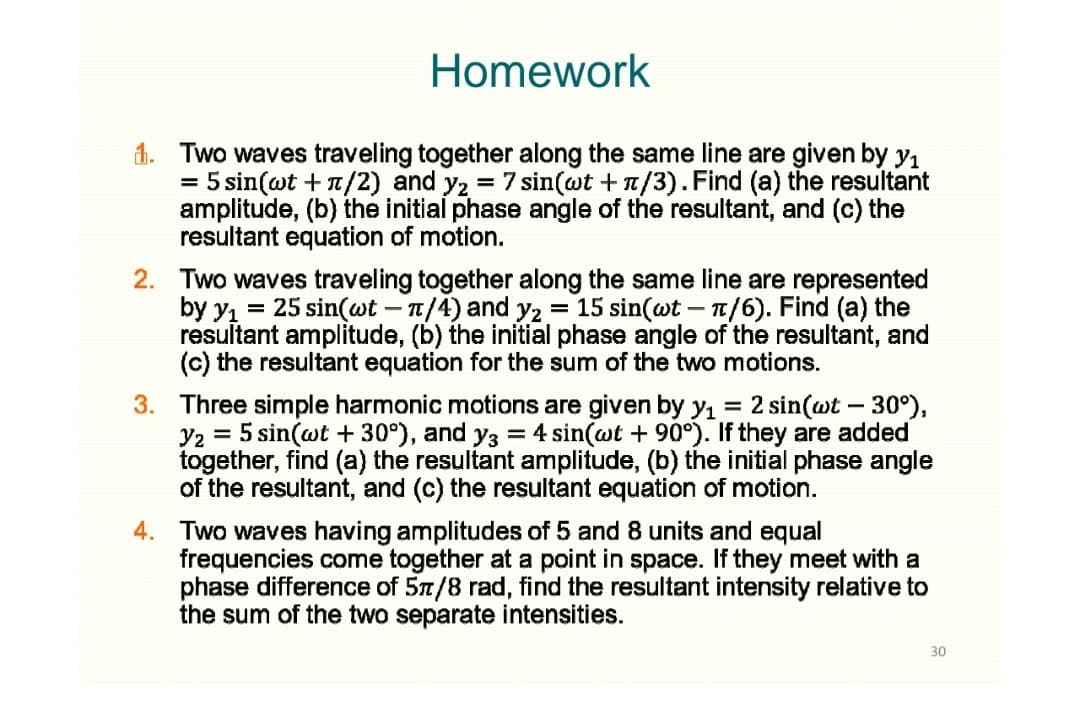Two waves having amplitudes of 5 and 8 units and equal frequencies come together at a point in space. If they meet with a phase difference of 57/8 rad, find the resultant intensity relative to the sum of the two separate intensities.
Two waves having amplitudes of 5 and 8 units and equal frequencies come together at a point in space. If they meet with a phase difference of 57/8 rad, find the resultant intensity relative to the sum of the two separate intensities.
Physics for Scientists and Engineers
10th Edition
ISBN:9781337553278
Author:Raymond A. Serway, John W. Jewett
Publisher:Raymond A. Serway, John W. Jewett
Chapter17: Superposition And Standing Waves
Section: Chapter Questions
Problem 50CP
Related questions
Question
100%
Two waves having amplitudes of 5 and 8 units and equal frequencies come together at a point in space. If they meet with a phase difference of 57/8 rad, find the resultant intensity relative to the sum of the two separate intensities.

Transcribed Image Text:Homework
1. Two waves traveling together along the same line are given by y1
5 sin(@t + n/2) and y2 = 7 sin(@t + 1/3). Find (a) the resultant
amplitude, (b) the initial phase angle of the resultant, and (c) the
resultant equation of motion.
%3D
2. Two waves traveling together along the same line are represented
by y1
= 25 sin(wt – T/4) and y2
resultant amplitude, (b) the initial phase angle of the resultant, and
(c) the resultant equation for the sum of the two motions.
= 15 sin(wt – T/6). Find (a) the
3. Three simple harmonic motions are given by y1 = 2 sin(wt – 30°),
Y2 = 5 sin(wt + 30°), and y3 = 4 sin(wt + 90°). If they are added
together, find
of the resultant, and (c) the resultant equation of motion.
the resultant amplitude, (b) the initial phase angle
4. Two waves having amplitudes of 5 and 8 units and equal
frequencies come together at a point in space. If they meet with a
phase difference of 57/8 rad, find the resultant intensity relative to
the sum of the two separate intensities.
30
Expert Solution
This question has been solved!
Explore an expertly crafted, step-by-step solution for a thorough understanding of key concepts.
This is a popular solution!
Trending now
This is a popular solution!
Step by step
Solved in 2 steps

Recommended textbooks for you

Physics for Scientists and Engineers
Physics
ISBN:
9781337553278
Author:
Raymond A. Serway, John W. Jewett
Publisher:
Cengage Learning

Physics for Scientists and Engineers with Modern …
Physics
ISBN:
9781337553292
Author:
Raymond A. Serway, John W. Jewett
Publisher:
Cengage Learning

Physics for Scientists and Engineers: Foundations…
Physics
ISBN:
9781133939146
Author:
Katz, Debora M.
Publisher:
Cengage Learning

Physics for Scientists and Engineers
Physics
ISBN:
9781337553278
Author:
Raymond A. Serway, John W. Jewett
Publisher:
Cengage Learning

Physics for Scientists and Engineers with Modern …
Physics
ISBN:
9781337553292
Author:
Raymond A. Serway, John W. Jewett
Publisher:
Cengage Learning

Physics for Scientists and Engineers: Foundations…
Physics
ISBN:
9781133939146
Author:
Katz, Debora M.
Publisher:
Cengage Learning

Physics for Scientists and Engineers, Technology …
Physics
ISBN:
9781305116399
Author:
Raymond A. Serway, John W. Jewett
Publisher:
Cengage Learning

University Physics Volume 1
Physics
ISBN:
9781938168277
Author:
William Moebs, Samuel J. Ling, Jeff Sanny
Publisher:
OpenStax - Rice University

Principles of Physics: A Calculus-Based Text
Physics
ISBN:
9781133104261
Author:
Raymond A. Serway, John W. Jewett
Publisher:
Cengage Learning